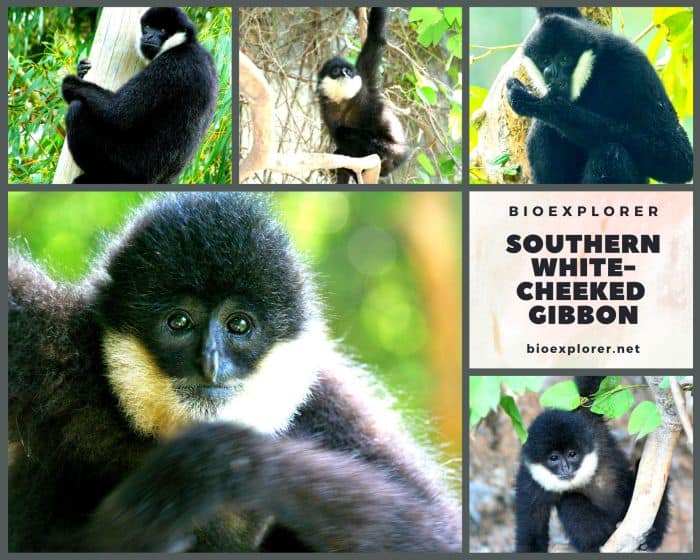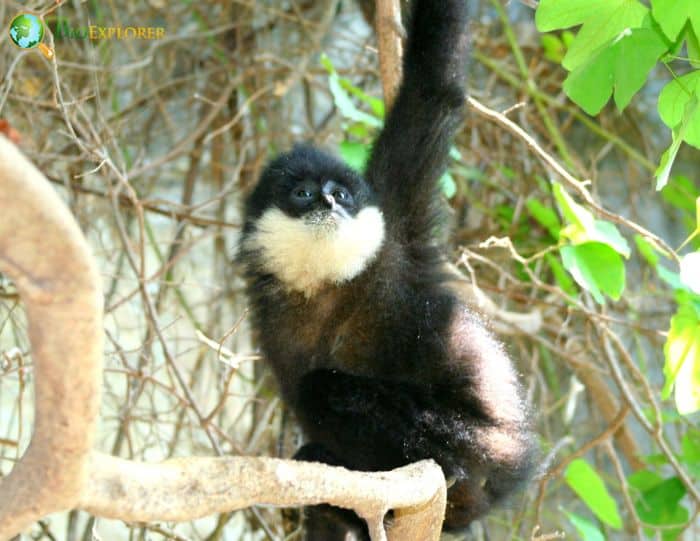
| Animalia | Primates | Hylobatidae | Nomascus | Nomascus siki |


- Common Name: Southern White-cheeked Crested Gibbon
- Taxonomy Classification Year: 1951
- Monkey Size: 45.7 to 63.5 cm (19 to 25 in)
- Skin Color(s): Coarse black or golden and reddish fur
- Habitat: Forest, rainforest
- Diet: Omnivorous
- Native Countries: Vietnam, Laos
Southern White-cheeked Crested Gibbon Distribution
Southern White-Cheeked Gibbon Characteristics

The southern white-cheeked gibbon[1] (Nomascus siki) is a species of gibbon endemic to Laos and Vietnam.

- It is closely related to the yellow-cheeked gibbon (Nomascus gabriellae) and Northern white-cheeked gibbon (Nomascus leucogenys).
- It has already been identified as a subspecies of each of them.
- Southern white-cheeked gibbons are sexually dichromatic, meaning the hairiness of each sex is quite different, clearly distinguishing females from males despite being roughly the same size.
- Females have golden and reddish fur, black faces, and black or dark brown hair on the crown. They have white fur around their face, which looks like a halo.
- Males have thick black fur and black facial skin with white cheek fur. They also have distinctive hair crests on the top of their heads.
- Babies are born with whitish-beige fur that turns black after the first two years of life. When they reach sexual maturity, the males remain black while the females turn into a golden whitish coat.
- Gibbons are very acrobatic primates and perfectly adapted to an arboreal lifestyle. They have long arms and fingers that allow them to propel themselves through the forest at speeds of up to 3 meters per stroke.
- In particular, their shoulder joints allow greater freedom of movement when swinging.

Southern White-Cheeked Gibbon Facts

- Southern white-cheeked gibbons are arboreal and live primarily in the forest canopy.
- They move by swinging through trees or swinging through trees while holding on to the branches above them.
- These gibbons are diurnal primates, spending most mornings and afternoons foraging while resting midday.
- They are monogamous and form long-lasting pair bonds, a trait rarely found in other ape species except for humans.
- There is a hierarchy within the group; the adult female is dominant, followed by her female offspring, then the male offspring; the adult man is the last.
Suggested Reading: Great Ape Species
Cite This Page
APA7MLA8Chicago
BioExplorer.net. (2025, October 14). Southern White-Cheeked Gibbon. Bio Explorer. https://www.bioexplorer.net/animals/mammals/apes/southern-white-cheeked-gibbon/.
BioExplorer.net. "Southern White-Cheeked Gibbon" Bio Explorer, 14 October 2025, https://www.bioexplorer.net/animals/mammals/apes/southern-white-cheeked-gibbon/.
BioExplorer.net. "Southern White-Cheeked Gibbon" Bio Explorer, October 14 2025. https://www.bioexplorer.net/animals/mammals/apes/southern-white-cheeked-gibbon/.











